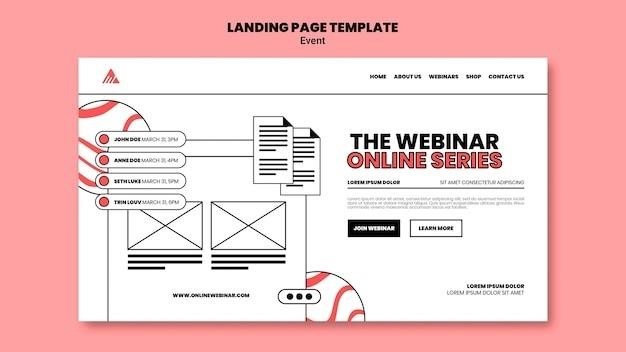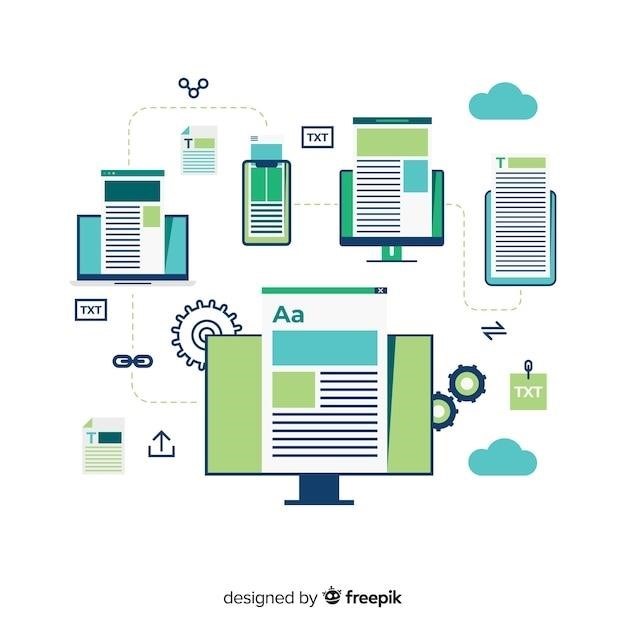Linearized PDF⁚ A Quick Introduction
A linearized PDF file is a specially constructed PDF which loads more quickly in a web browser for display purposes. This is achieved by reorganizing the internal structure of the PDF file so that the first page can be displayed before the entire file is downloaded.
What is a Linearized PDF?
A linearized PDF is a specialized format of a PDF file optimized for faster web viewing. Unlike a standard PDF, which downloads the entire file before displaying any content, a linearized PDF allows a web browser to render the first page as it downloads the file. This is achieved by rearranging the internal structure of the PDF, placing the information needed for the first page at the beginning of the file. This significantly reduces the loading time, especially for large or complex PDFs, providing a more seamless user experience.
Benefits of Linearization
Linearization of PDF files offers several advantages for both document creators and users. Primarily, it significantly improves the web viewing experience by allowing users to see the first page of a PDF document almost instantly, without waiting for the entire file to download. This is especially beneficial for large or complex PDFs, which can take a considerable amount of time to load. Additionally, linearization can enhance accessibility for users with slower internet connections, providing them with a more responsive and engaging experience.
How Linearization Works
Linearization involves restructuring the internal data of a PDF file. Instead of storing information about each page scattered throughout the file, linearization places the data for each page in a sequential order. This means that the data for the first page is located at the beginning of the file, followed by the data for the second page, and so on. The file also includes a table of offsets, which allows the viewer to quickly locate the data for any specific page. This streamlined organization enables byte-streaming, where the viewer can download and display each page as it becomes available, resulting in a much faster browsing experience.

Creating Linearized PDFs
Linearized PDFs can be created using specialized software or through manual steps, both of which involve rearranging the internal structure of the PDF file.
Software for Linearization
Several software programs offer PDF linearization capabilities, simplifying the process for users. Popular options include Adobe Acrobat, which provides a dedicated linearization feature within its interface. Other tools like Nitro Pro and PDFelement also include functionalities for creating linearized PDFs. These software solutions typically offer user-friendly interfaces, allowing users to select the desired settings and initiate the linearization process with ease.
Manual Linearization Steps
While software tools streamline the process, it’s possible to linearize PDFs manually using specialized tools and commands. This involves manipulating the PDF’s internal structure using a command-line tool or a text editor. The process typically involves rearranging the order of objects within the PDF file, ensuring that the first page’s data is placed at the beginning. Additionally, a table of offsets and byte sizes, known as a hints table, is created and inserted at the beginning of the file. This hints table guides the browser in efficiently downloading and displaying the PDF’s pages.
Linearization in Practice
Linearization significantly enhances the user experience, particularly for large PDFs viewed online.
Web Viewing and Linearization
Linearization is particularly beneficial for web viewing, enabling faster loading times and improved user experience. When a standard PDF is opened in a web browser, the entire file needs to be downloaded before the first page can be displayed. This can be a major inconvenience for large documents, especially when users are on slower internet connections.
A linearized PDF, however, allows the first page to be displayed almost instantly, even if the entire file is not yet downloaded. This is because the data for the first page is placed at the beginning of the file, enabling the web browser to start rendering the page immediately. As the rest of the file continues to download, subsequent pages are displayed in sequence, providing a seamless browsing experience.
Linearization for Large Documents
Linearization proves particularly advantageous for large documents, where the benefits of faster loading times are most pronounced. Imagine trying to view a lengthy technical manual or a comprehensive research paper in a standard PDF format. Without linearization, you would be forced to wait for the entire document to download before you can even start reading the first page.
By contrast, a linearized PDF allows you to access the first page immediately, enabling you to start reading and navigating the document without delay. This is especially beneficial for users who need to quickly find specific information within a large document, as they can efficiently browse the document’s content without having to wait for the entire file to load.
Limitations of Linearization
While linearization offers a significant performance boost for web viewing, it’s not without its limitations. One key limitation is that it doesn’t reduce the overall file size of the PDF document. Linearization simply reorganizes the existing data within the file, ensuring faster access to the first page.
Moreover, linearization primarily benefits web viewing scenarios and may not have a significant impact on the loading time of a PDF file when opened locally. The process of linearization can also introduce a slight increase in file size due to the addition of metadata and structural information.

Linearization and Related Concepts
Linearization is closely linked to concepts like PDF optimization, byte-streaming, and the structure of PDF files themselves.
PDF Optimization
PDF optimization is a broader process that aims to reduce the file size of a PDF document without compromising its visual quality or functionality. This involves techniques like compressing images, removing unnecessary objects, and streamlining the document structure. While linearization focuses on improving web viewing speed, PDF optimization aims to improve overall file size and download time. Linearization can be a part of a broader PDF optimization strategy, but it’s not the only factor involved.
Byte-Streaming
Byte-streaming is a technique used for transmitting data over a network, where data is sent in small chunks (bytes) rather than as a single, complete file. This allows the recipient to start processing the data as it arrives, rather than waiting for the entire file to download. Linearized PDFs leverage byte-streaming by organizing the file’s content so that the first page’s data is located at the beginning of the file. This enables web browsers to display the first page quickly, even while the rest of the file is still being downloaded. Byte-streaming, in conjunction with linearization, makes web viewing of PDFs more efficient and responsive.
PDF Structure and Object Trees
Understanding the structure of a PDF file is crucial for comprehending how linearization works. PDFs are composed of objects, which are self-contained units of data. These objects are organized into an object tree, a hierarchical structure that defines the relationships between different objects. Linearization optimizes this structure by rearranging the objects in a specific order. The first page’s objects are placed at the beginning of the file, followed by subsequent page objects. This ensures that the browser can quickly access the data needed to display the first page while the remaining pages are downloaded in the background. This optimized structure allows for efficient streaming of the PDF content.
Applications of Linearization
Linearization plays a crucial role in various applications, enhancing web-based document sharing, e-commerce, online publishing, and digital libraries.
Web-Based Document Sharing
Linearized PDFs significantly enhance web-based document sharing by enabling faster loading times and improved user experience. When a user accesses a linearized PDF on a web browser, the first page loads almost instantly, allowing them to start reading or reviewing the document without delay. This is especially beneficial for large documents, where traditional PDFs can take considerable time to download and display fully. The ability to quickly view the first page encourages users to engage with the content and explore the document further, leading to better document accessibility and user satisfaction.
E-Commerce and Online Publishing
Linearized PDFs play a crucial role in e-commerce and online publishing by providing a seamless and efficient user experience. When product catalogs, brochures, or online publications are delivered as linearized PDFs, they load quickly, allowing customers and readers to browse and interact with the content without waiting for lengthy downloads. This speed and responsiveness are essential for engaging customers and driving conversions. The fast loading times also improve accessibility, enabling users with slower internet connections to easily access and consume the information, enhancing their overall online experience.
Digital Libraries and Archives
Linearized PDFs are invaluable for digital libraries and archives, facilitating the preservation and accessibility of historical documents, research papers, and other valuable materials. By ensuring that the first page of a document loads quickly, linearized PDFs allow users to browse through large collections more efficiently. This is crucial for researchers and scholars who may need to access a wide range of documents. The fast loading times also reduce the strain on server resources, ensuring that digital libraries can manage and deliver their collections effectively. Linearized PDFs also contribute to long-term preservation by making it easier to store and retrieve documents in a format that is compatible with a wide range of devices and platforms.
